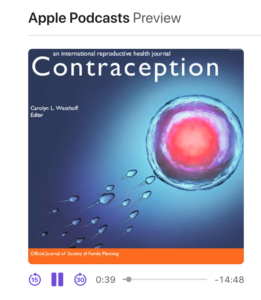Stream the podcast, featuring a MyVoice research paper “Youth opinions about Title X funding and policy in the United States: A mixed methods text message survey”
Shortly after the United States saw major changes to a federal policy on reproductive health in 2019, MyVoice asked our cohort of youth what they thought. They responded in over 5,000 text messages to us, as part of an October 2019 text message poll on Title X. Those responses were synthesized by a team of MyVoice researchers and summarized in a paper published in the academic research journal Contraception, just last month. The paper is titled “Youth opinions about Title X funding and policy in the United States: A mixed methods text message survey” and was featured in a podcast discussion with the journal’s editors. Stream the episode via Apple Podcast or on the web.
In the episode, MyVoice and the core team gets a huge shoutout from the paper’s lead author, family physician and reproductive health provider Dr. Justine Wu. The paper co-authors include Murphy Van Sparrentak, Marika Waselewski, Melissa DeJonckheere, Tammy Chang, and family physician Dr. Razel Remen.
What is “Title X”?
From the paper: “Established in 1970, Title X of the Public Health Service Act is the largest source of federal funding for sexual and reproductive health services that aim to provide access to youth and low-income populations. Since 1976, Title X funds have been barred from covering abortion-related services. However, Title X providers had been required to provide nondirective pregnancy counseling, including abortion referrals upon client request. In March 2019, the U.S. Department of Health and Human Services made changes to Title X regulations that included the removal of the pregnancy counseling requirement and prohibited discussions that could “promote, refer for, or support abortion as a method of family planning.” A widely-held interpretation of this statute is that clinics that do not fully comply would become ineligible for Title X funding. By December 2019, nearly one in four Title X clinics had withdrawn from the network or stopped using Title X funds, including the Planned Parenthood Federation of America (PPFA).”
Why ask youth about Title X changes?
“The Title X policy change spurred strong reactions from the public, policy makers, and the medical and scientific community. Individuals 24 and younger account for 42% of Title X clients and are key stakeholders in Title X policy, yet their voices have been largely unheard. In this study, we sought to assess youth awareness and opinions of Title X and recent policy changes.”
What did researchers conclude?
Seven hundred and fifty youth responded to the text message survey (58.0% response rate). The majority (74.9%) was unaware of recent Title X changes. Most (79.3%) were unsupportive of these changes, and a sizable portion (40%) worried these changes could impact them. Opposition to Title X changes was based upon five themes: (1) youth need to be aware of their health options, including abortion; (2) the policy will undermine reproductive rights; (3) the policy is unfair; (4) the policy is unconstitutional; (5) the policy will threaten public health and health services, including affordable and safe abortion. Those who supported Title X changes (13.8%) described moral objections to abortion and beliefs that the government should not be responsible for abortion care. Most youth in this sample were unsupportive of Title X changes. Limited youth awareness of Title X changes suggests that better youth outreach is needed regarding sexual and reproductive health (SRH) policies.
Although youth represent 40% of clients who receive SRH services through Title X, more efforts are needed to inform and engage them in salient policy changes that may directly affect their SRH health and health care access.

